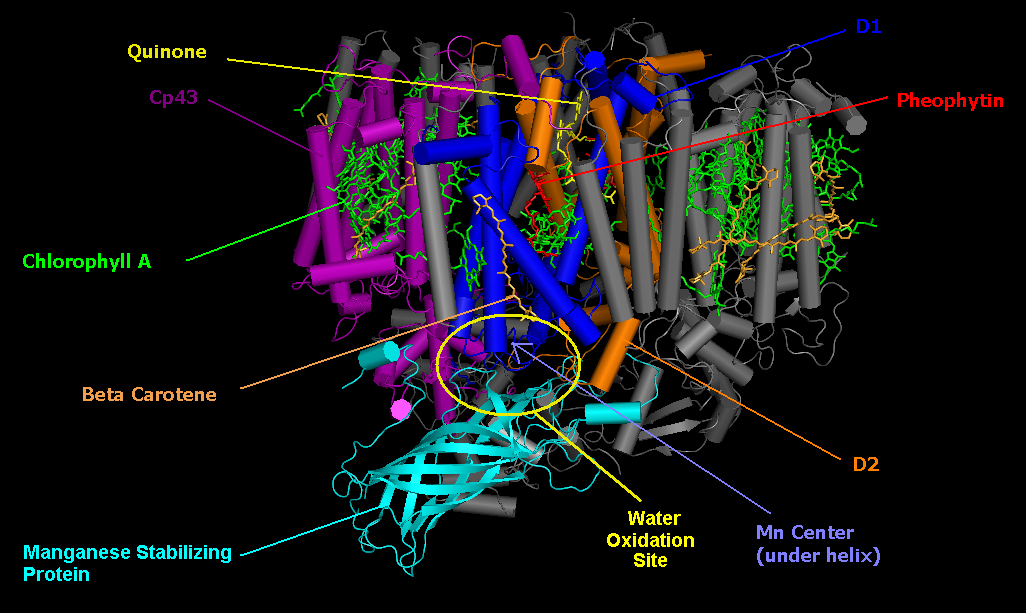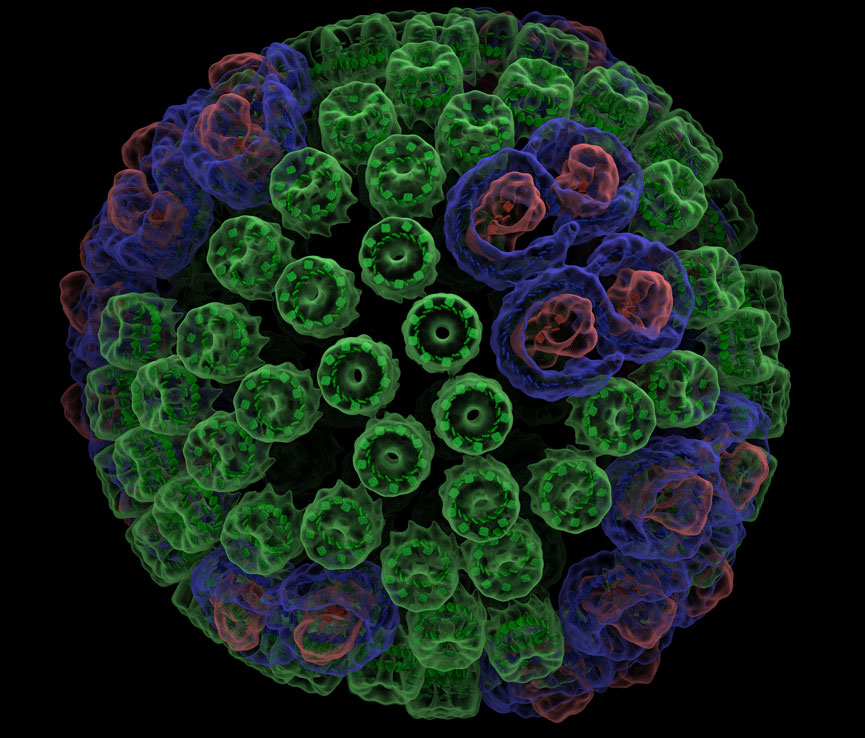Imagine a time when our young Earth was spinning much faster and days were only 8 hours! Our sun was much cooler and less bright than today. There was no oxygen in the atmosphere. Those were the conditions when first photosynthetic organisms with purple pigments evolved in liquid environments. In this animation we see one such ancestral form of early anoxic photosynthesis taking place in the purple bacteria Rhodobacter sphaeroides in which oxygen is not produced. Life evolved into oxygen producing photosynthesis much later. In this early form of bacterial photosynthesis water is not split and therefore oxygen is not produced. Life had to experiment for a very long time to invent a photosynthetic machinery (Photosystem II) with a Reaction Center (RC) powerful enough to split water to release oxygen. Check out the side view of reaction center molecule of the cyano-bacteria (blue-green algae) Thermosynechococcus elongatus below. It is oriented to capture light raining from above. The reaction center of Thermosynechococcus elongatus has the power to split water to produce oxygen:
Photosystem-II 2AXT” by Neveu,Curtis (C31004). Licensed under CC BY-SA 3.0 via Commons
Atmospheric oxygen is the biggest evidence (biosignature) for existence of life on our planet. Oxygenic photosynthesis by single-celled organisms triggered the Great Oxidation Event 2.7 billion years ago. Accumulation of oxygen in the atmosphere enabled formation of ozone layer to filter out deadly UV radiation. Only then life was able to get out of water and colonize the land. Plants were the pioneers in this adventure. There is evidence that photosynthetic organisms were colonizing land surfaces as early as 850 million years ago.
In this animation we see one of the earliest evolutionary example of Light reactions. These reactions are connected to Dark reactions which are not shown here. As the light reactions evolved so did the Dark reactions. There are three major dark reactions known as (C3-C4-CAM).
The ancestral purple bacteria such as Rhodobacter sphaeroides still thrives today in watery environments. This outstanding animation shows in exquisite detail how a green-purple bacteria photosynthesizes today. It also helps us understand how early photosynthesizing organisms were able to survive in a world dominated by methanogens which catastrophically became marginal organisms in our oxygen dominated planet.
According to one hypothesis, 2.7 billion years ago oceans began to receive less mineral nutrients due to an abrubt reduction in volcanic activity. Nickel was a key cofactor used in a crucial enzyme of methane producing unicellular organisms (they were not bacteria) that dominated the oceans by that time. Nickel starvation reduced methane production which is a strong greenhouse gas and lead to extreme drop in global temperatures. Major geological events such as Snowball (or Slashball) Earth prepared the conditions that lead to subsequent emergence of multicellular life.
Video work from Klaus Schulten and Melih Sener.
Photosynthesis provides energy for most life on Earth. Light-harvesting reactions in photosynthesis, require the cooperation of hundreds of proteins. In purple bacteria light-harvesting takes place in structures called chromatophores. Researchers in Beckman Institute, UIUC gathered data generated by many scientists studying chromatophores over three decades and combined them into a single visualization. This incredible 100-million-atom model details the biochemical sequence of events taking place on the surface of the inner photosynthetic membrane.
Chromatophores are tiny spherical membranes of 50 nanometers inner diameter size. They form dome-shaped structures made up of over a hundred proteins and ∼3000 bacteriochlorophylls absorbing photons.
During the initial steps of photosynthesis, two types of light-harvesting proteins absorb wavelengths of light that lift them into an excited state. This electronic excitation travels through the light-harvesting network to the third type of protein, known as the reaction center. Here, electrical energy is converted into an initial form of chemical energy. Molecules called quinols carry this chemical energy across the organelle to the fourth type of protein—the bc1 complex—where a charge separation process strips the quinol of electrons. This process triggers a current of protons in the fifth type of protein, known as ATP synthase, driving the molecule’s paddle wheel-like c-ring to produce ATP.
light harvesting complexes LH1 and LH2
reaction center RC
bc1 complex
ATP synthase
We are no stranger to Quinone! A new type of quinone-based “cabbage battery” is under development that could fundamentally transform the way electricity is stored. Flow cells will render power from renewable energy sources such as wind and solar far more economical and reliable. Connecticut-based Sustainable Innovations, LLC, a collaborator on the project, expects to deploy demonstration versions of the organic flow battery contained in a unit the size of a horse trailer. The portable, scaled-up storage system could be hooked up to solar panels on the roof of a commercial building, and electricity from the solar panels could either directly supply the needs of the building or go into storage and come out of storage when there’s a need.
This work is an impressive distillation. It is hard to consume multiple decades of hard laboratory work in just a few minutes. The following two videos are faster overviews of the process each with a different emphasis. The first video shows how proteins forming the chromatophore are embedded in a lipid membrane. We must appreciate this since for scientists it is extremely difficult to resolve the structures of proteins that have the habit of hiding a great portion of themselves inside lipid.
Understanding of photosynthesis was a major breakthrough for our understanding of nature. Aristotle for example was clueless about the subject. He applied an animal model of feeding on plants. Like Africans envisioned Baobaps as upside down trees he thought all plants were upside down, mouths burried in soil and bottoms exposed to the sky. He envisioned plants fed through their roots and excreted fruits. True nature of photosynthesis began to be understood only after 1771.
If you want to dig in further into the molecular details a must read book is the Molecular Mechanisms of Photosynthesis by Robert E. Blankenship of the University of Washington.




3 Comments